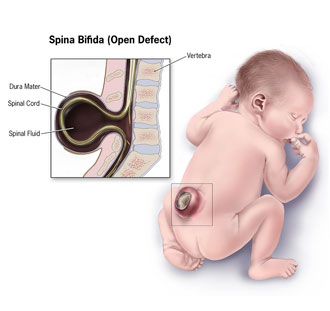
SIGNS AND SYMPTOMS
Physical problems
Physical signs of spina bifida may include:
- Leg weakness and paralysis
- Orthopedic abnormalities (i.e., club foot, hip dislocation, scoliosis)
- Bladder and bowel control problems, including incontinence, urinary tract infections, and poor kidney function
- Pressure sores and skin irritations
- Abnormal eye movement
Neurological problems
Many individuals with spina bifida have an associated abnormality of the cerebellum. In affected individuals, the back portion of the brain is displaced from the back of the skull down into the upper neck. In fact, the cerebellum also tends to be smaller in individuals with spina bifida, especially for those with higher lesion levels.
Executive function
- Specific areas of difficulty in some individuals include planning, organizing, initiating, and working memory
- Problem-solving, abstraction, and visual planning may also be impaired.Further,
- Children with spina bifida may have poor cognitive flexibility
- Individuals with spina bifida, especially those with shunted hydrocephalus, often have attention problems
- Deficits have been observed for selective attention and focused attention, although poor motor speed may contribute to poor scores on tests of attention
- Attention deficits may be evident at a very early age, as infants with spina bifida lag behind their peers in orienting to faces
Academic skills
- Individuals with spina bifida may struggle academically, especially in the subjects of mathematics and reading
- Children with spina bifida may perform well in elementary school, but begin to struggle as academic demands increase
- Children with spina bifida are more likely than their peers without spina bifida to be dyscalculic Individuals with spina bifida have demonstrated stable difficulties with arithmetic accuracy and speed, mathematical problem-solving and general use and understanding of numbers in everyday life.
- Individuals with spina bifida tend to have better reading skills than mathematics skills
- Children and adults with spina bifida have stronger abilities in reading accuracy than in reading comprehension. Comprehension may be especially impaired for text that requires an abstract synthesis of information rather than a more literal understanding
- Individuals with spina bifida may have difficulty with writing due to deficits in fine motor control and working memory
TREATMENT
- Physical therapy
- Occupational therapy
- Remedial tutoring (special education)
- Sensory integration therapy
- Brain gym
- Handwriting without tears program
- PECS(Picture exchange communication system)
- Kinesiotaping
- Pre-vocational training
- Vocational training
- Orthotic support
- Schooling at special school
